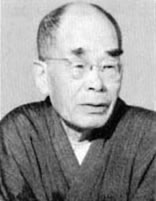
D. Sources of Influence and Transmission
28. Suzuki, D. T. Works 1927~38.
The influence of Suzuki’s Zen is far-reaching and widely acknowledged among American and European intellectuals, artists, and poets after the Second World War, but Suzuki is of importance here largely because of Yeats’s interest in his work and possible incorporation of its principles into his poems, a matter about which several critics have made broad claims. That Yeats knew Suzuki’s writing, took it seriously, and derived his late understanding of Zen largely from it is certain. He first makes reference in print to the ‘contemplative school of [Japanese] Buddhism’ in his 1916 defence of the nô (BL11), and to that ‘school’ by name in a 1926 letter to Sturge Moore (BL47b), but shortly after publication of the first series of Suzuki’s Essays in Zen Buddhism (London: Luzac, 1927) Yeats had a copy of the work (see BL67), and thereafter his understanding of Zen is traceable to it, Suzuki’s Zen Buddhism and Its Influence on Japanese Culture (Kyoto: Eastern Buddhist Society, 1938; see BL48u), and Suzuki’s journal the Eastern Buddhist (see BL53 and 228). Yeats was in correspondence with Suzuki by 1928, writing that he had the ‘poems’ (i.e. koan) of Essays ‘constantly on [his] lips’ (see BL53), and in that year wrote to another Japanese correspondent of an interest in travelling to Japan to further explore the country’s ‘philosophy’ (see BL52e). Passages traceable to the Essays appear in the second edition of A Vision (BL38, 38a), Yeats’s introduction to Patanjali’s Aphorisms of Yôga (BL42), and Pages from a Diary Written in Nineteen Hundred and Thirty (BL46b). Beyond this, the evidence critics cite for an influence from Suzuki and Zen in Yeats’s poems, most notably DEMON AND BEAST (BL16), Among School Children (BL29), DIALOGUE OF SELF AND SOUL (BL30a), BYZANTIUM (BL32a), LAPIS LAZULI (BL40), and THE STATUES (BL43), is sometimes convincing and sometimes not. One cannot easily dispute the general point that Yeats incorporated an understanding of Zen via Suzuki into the epistemological stance underlying his late poems, but specific critical explorations of the issue often place squarely at Suzuki’s doorstep lines and understandings demonstrably derived from a complex mixture of sources (see notes about this at BL196). For other Yeats references to Suzuki or Zen see BL43, 47d, 48n, and 49; for discussion of the influence of Zen in his poetry see BL66, 83, 85, 113, 124c, 124e, 124g, 124i, 131a, 133, 146, 159, 163, 165, 170, 198, 211, 220, 224, 234, 244, and 255; and for related material see BL31, 48c, 76, 80, and 124. Discussion of Suzuki’s larger influence in English-language literature may be found in A31 and A49a-b. See also Masao Abe, ed., A Zen Life: D. T. Suzuki Remembered (Tokyo: Weatherhill, 1986), particularly Christmas Humphries’s ‘Dr. D. T. Suzuki and Zen Buddhism in Europe’, Larry Fader’s ‘D. T. Suzuki’s Contribution to the West’, and Abe’s ‘The Influence of D. T. Suzuki in the West’.















